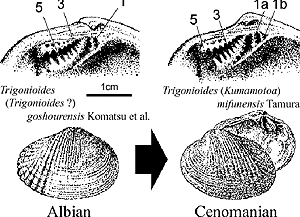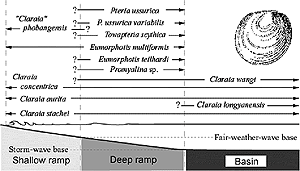
Figure 1 Comparison of the hinge structures of the Cretaceous Albian Trigonioides goshourensis and the Cenomanian T. mifunensis (Modified from Komatsu et al., 2007).
【化石群集と堆積環境の復元】
地層や化石は、地質時代や進化史、古環境に関連する重要な情報を我々にもたらす。堆積環境は、堆積相解析に基づいて、岩相や粒子サイズ、粒子配列、堆積構造によって推定され、化石群集は、化石の産状や保存状態、構成から復元される。
【海洋底生生物群集の進化】
中生代の軟体動物化石は、進化や古環境などを研究する上で大切であり、これらのデータによって東アジアにおける様々な地層の堆積環境や化石群集が復元された (Figures 1, 2)。なお海洋底生生物の適応放散は、大量絶滅後などに起こっており、この現象は強い捕食圧に影響される場合があることが明らかになっている。

Figure 1 Comparison of the hinge structures of the Cretaceous Albian Trigonioides goshourensis and the Cenomanian T. mifunensis (Modified from Komatsu et al., 2007).

Figure 2 Reconstructed habitats of the Lower Triassic bivalves.
Reconstruction of fossil association and depositional environment : Strata and fossils provide important information on geological age, evolutionary history, and the paleoenvironment. Depositional environments can be inferred from the lithology, grain-size distribution, grain fabric, and sedimentary structure on the basis of facies analysis. Fossil associations can be reconstructed from the mode of occurrence, preservation, and shell composition.
Evolution of marine benthic association : Abundant Mesozoic molluscan fossils are available for analysis, allowing the depositional environments and fossil associations to be reconstructed for various strata in East Asia. The geological timing of certain assemblages is well constrained by the adaptive radiation of marine benthos, often following mass extinction events and in some cases due to serious predation pressures.